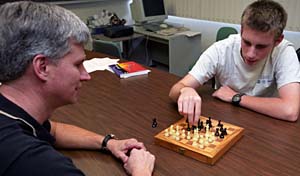A 17-year-old student from John Burroughs School spent a good portion of this summer working with a University mentor to develop a program that someday will make a gamer “rage against the machine.”
Steven Anderson of Creve Coeur, Mo., spent six weeks working with Stan Kwasny, Ph.D., research associate in computer science and engineering, on developing a computer program that can play a human in the extremely challenging game of Arimaa, a board game similar to chess but more difficult for a computer to beat.

Inspired by IBM’s Deep Blue, which beat chess world champion Garry Kasparov in 1997, computer programmer Omar Syed invented the game and then offered a challenge: a $10,000 award to anyone who can create a program that can beat a human at Arimaa before 2020.
Anderson has keen sights on getting a start to do just that.
For six weeks, Anderson, using artificial intelligence (A.I.) approaches, developed a program that prunes from tens of thousands of potential Arimaa moves to focus on about 100 moves for serious consideration, all the while learning the program language JAVA, writing a 15-page research paper and taking notes for a 10-minute oral presentation.
He is one of 48 academically talented high-school juniors and seniors who partook in the Pfizer Inc. and Solutia Inc. 2004 Students and Teachers as Research Scientists (STARS) program. It pairs students and teachers with research mentors from the University of Missouri-St. Louis, Saint Louis University and Washington University.
Forty-five students from 18 high schools in the St. Louis metro area and three students from around the country participated in the program.
For six weeks, biologists, chemists, computer scientists, engineers, medical researchers and psychologists at the three institutions have taken student apprentices under their wings in their laboratories, sharing their expertise as they direct the students in research projects.
“Through teacher-student-mentor-scientist partnerships, participants apply various problem-solving strategies to independent research projects,” said Ken Mares, director of the STARS program. “They write technical reports and orally present their results in a seminar format.
“This may be the best group ever. Eighteen of the students are in the top 10 of their class, and 38 have grade-point averages of 4.0 or higher.”
This year’s STARS program, “Experiencing the Scientific Enterprise,” started June 14 and ends today. Besides conducting research and presenting papers, students toured scientific enterprises in St. Louis, took part in career workshops and attended lectures by leading scientists in the St. Louis community.
Operational since 1990, the program has become a generational thing.
Anderson’s classmate at John Burroughs, Jessica Rubin, worked with Katherine Weilbaecher, M.D., assistant professor of medicine, and also with Weilbaecher’s graduate student Angie Hirbe, a Washington University and STARS alum. So, a former STARS student this year taught a current STARS student — a first, Mares said.
To select Arimaa moves for further consideration, Anderson and Kwasny had to build an intelligent move-generator capable of producing all legal moves, but with the best moves generated first to simplify the pruning process, “an extremely daunting task,” Kwasny said. “Any single board configuration can have as many as 40,000 move choices.”
“This game is actually designed to defeat any A.I. approach,” he added. “It’s hoped that the research that comes out of this effort improves A.I. technology. Still, we’re in uncharted territory.
“Steven has done a tremendous job with this. The STARS program, because it’s so short, offers a good starting point. This is something Steven can go back to from time to time, if he wants to.”
Anderson found the STARS experience challenging, fun and valuable.
“It was good to become so involved in a focused research project,” he said. “It was fun working with Dr. Kwasny, and I learned a lot.”
He said he especially found a STARS presentation by Frank Yin, M.D., Ph.D., the Stephen and Camilla Brauer Professor of Biomedical Engineering and chair of the department, helpful because he’s interested in a possible biomedical engineering career. He’s looked into Washington University, the University of Illinois, the University of Michigan, and Northwestern, Johns Hopkins, Carnegie Mellon and Case Western Reserve universities.
Kwasny has mentored a STARS student every summer but one since 1992.
“The STARS program’s reputation has really grown over the past decade, with more schools showing interest all the time,” Kwasny said. “It’s a rare opportunity for a high-school student to participate in a research project that emphasizes doing science, writing about it and giving an oral presentation.
“That’s the essence of a science career right there.”